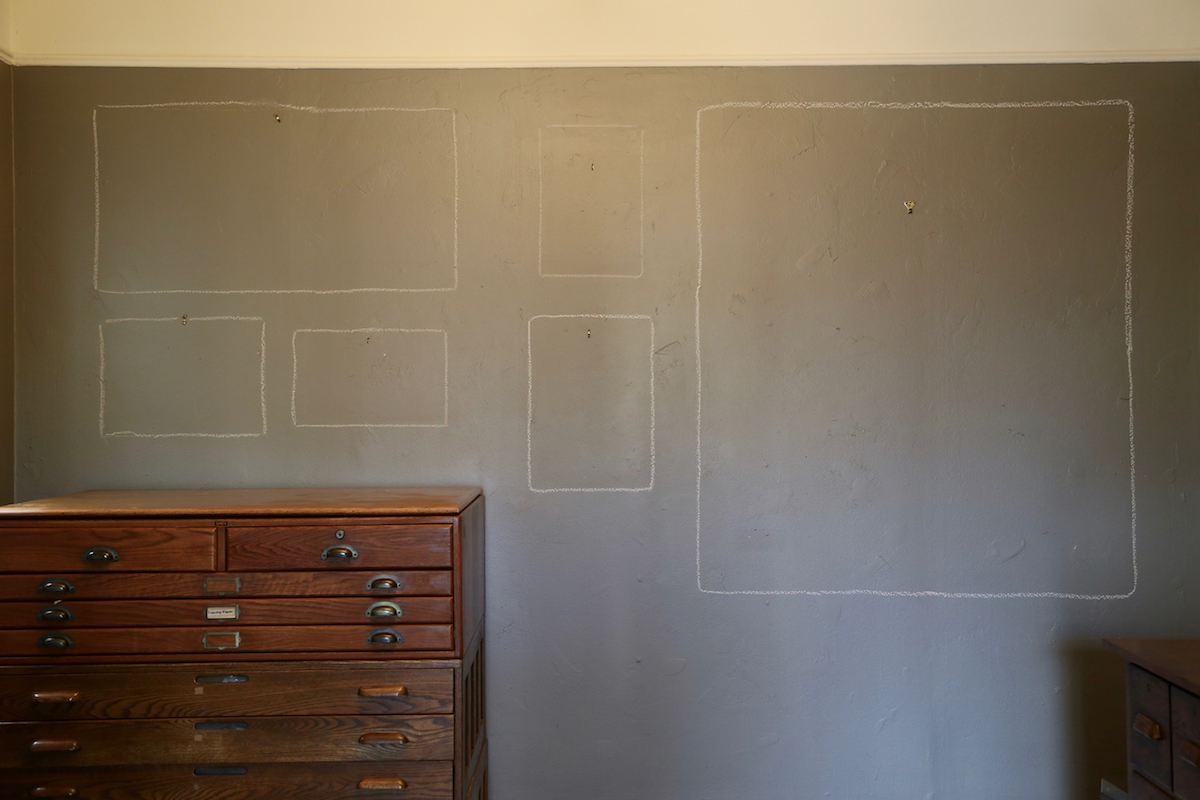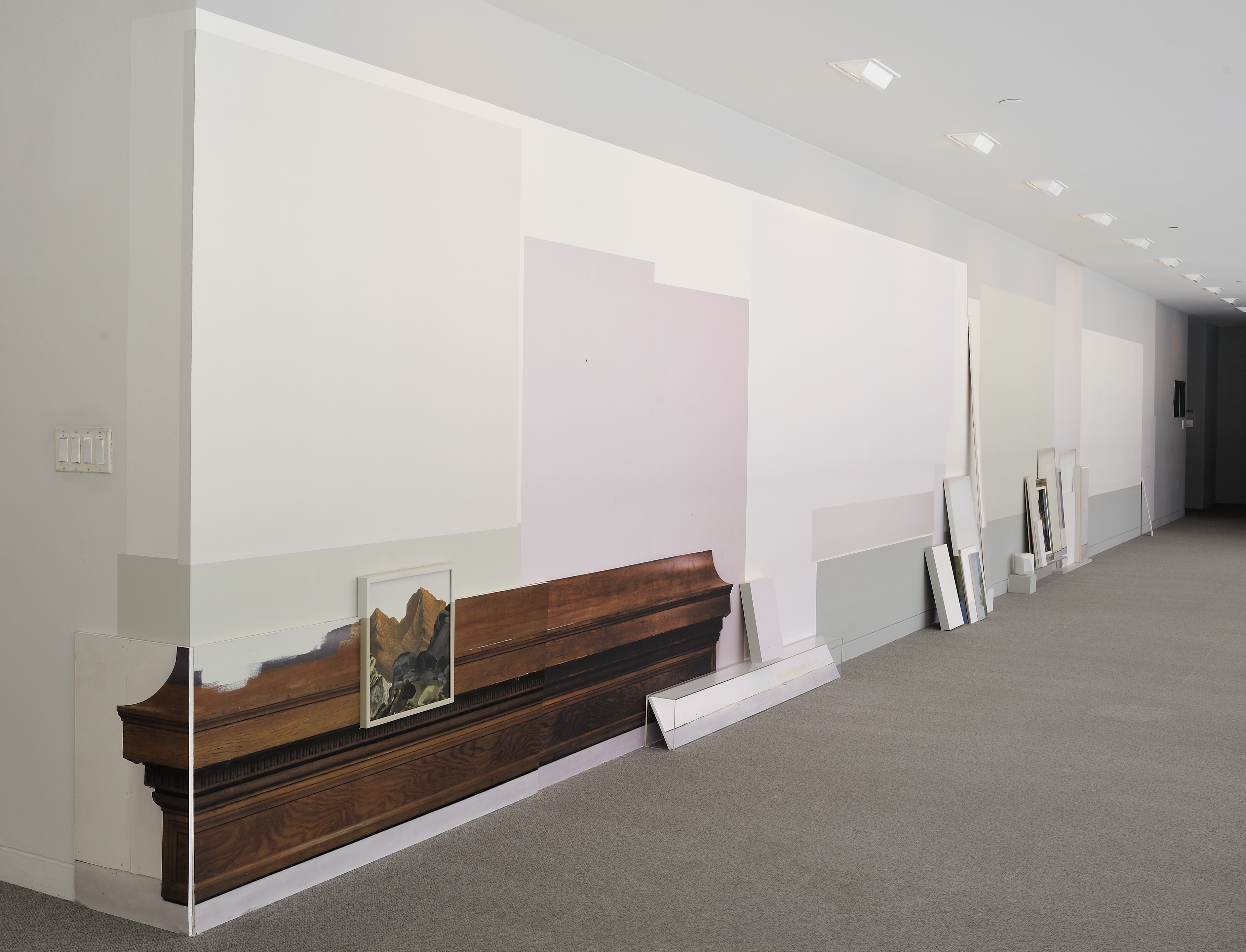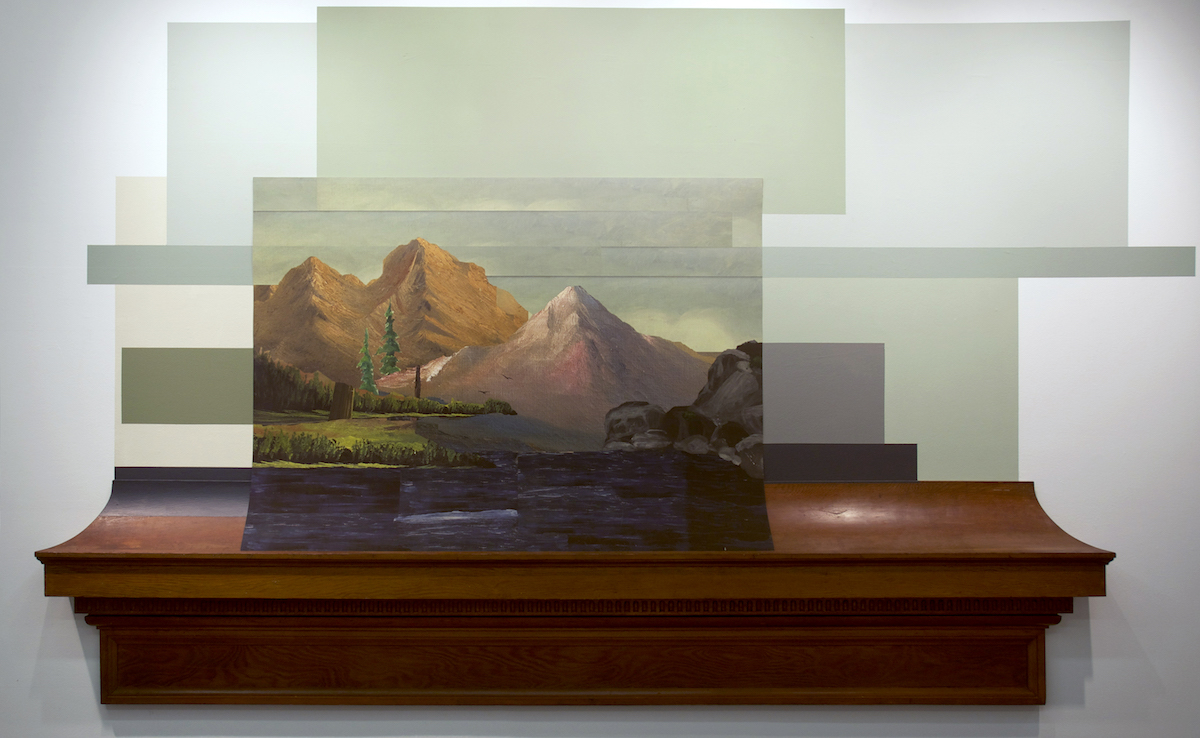castaneda/reiman: Lay of the Landscape
- Joanna Fiduccia
The last time Charlie Castaneda moved, her longtime collaborator Brody Reiman helped transport the apartment’s sizeable collection of landscape paintings to their shared studio. Their first step, however, was to trace the paintings’ frames in chalk on the dove-gray walls. Through these wobbly rectangles, the landscapes found themselves abruptly inverted; from windows onto the wilderness, they became, in their absence, things among things in the steadily emptying rooms.
By now, it is commonplace to recognize landscapes as mediated constructions that represent as well as carry out cultural power—“social hieroglyphs” in the words of W.J.T. Mitchell, encrypting their force in conventionality.1 But castaneda/reiman’s landscapes are also constructions in a stricter sense: objects to be ferried from one place to another, hung in their homes, and apostrophized in their installations. The outlines of their frames on the apartment walls suggested a new order of classification, by dimension rather than content. At Mills, this order prevails in the museum’s vertical storage. Works in the MCAM collection are hung on a series of sliding walls placed closed to one another on parallel tracks, a system that allows the paintings to be viewed easily by drawing out one of the walls from the ranks, but also entails grouping paintings by the width of their canvases or frames instead of their subject matter or style. In profile, the collection becomes constituted of objects instead of pictures.
 Figure 8
Figure 8
Castaneda/reiman have steadily amassed their collection of landscape paintings over almost three decades, since the two artists first began working together as undergraduates at Carnegie Mellon in the early 1990s. Most of the paintings were acquired at garage sales or second-hand stores during cross-country trips. They were souvenirs of their travels, albeit often oblique ones, since they most often represented scenery that pointed away from the place where they bought the landscapes, just as one might find a painting of Niagara Falls hanging in a Texas dining room or a print of the redwoods displayed on the wall of a Kansas bedroom. Each painting has therefore been, always already, a sight/site within a sight/site—ever directing the imagination out of its environment, ever nesting one place inside another. This compounded displacement suggests what Rachel Ziady DeLue calls landscape’s “apositionality” or its quality of being “neither foreground nor background, center nor periphery.”2 It is a quality preeminently on display in castaneda/reiman’s installations. In these projects, what appear from afar to be clusters of paintings leaning casually against the wall are, in fact, replicas of landscapes in their collection. A nod to the artists’ experience working in construction, these proxies are made from building materials—pigmented drywall mud troweled onto wood boards and MDF; drywall printed with facsimiles; wallpaper that stretches the palette of a painting across the length of a gallery. These components, in turn, accent the materiality of the more conventional artistic supports and processes at the basis of their installations, including photography’s layers and seams and the textures and imperfections of canvas. Taken altogether, the array is disorienting, as though you had turned a corner in your own home and come upon a major renovation by surprise. It is not quite the walls, you feel, that are being dismantled, but the whole solid and yet invisible substrate of your surroundings.
 Figure 9
Figure 9
The result is a delamination of landscape painting’s domestication of nature, an operation dependent upon the invisibility of the barrier that secures domestic space itself—the paint, drywall, studs, and nails—to keep the outside world on the outside. For the built world is inadmissible both to the domestic interior, insofar as it offers a metaphorical container for the natural self, and to the landscape, imagined as a wild space unaltered by our labors. Consider, for instance, René Magritte’s The Human Condition (1933), one of several paintings of similar motif, which depicts a landscape on an easel placed in front of—and formally undifferentiated from—the view outside a window. For castaneda/reiman, however, the essential insight is not the equivalence of the painted and the perceived landscape but rather their complex interaction. Their use of construction materials, which suggest the dismantling of solid walls and humdrum images alike, sets a third term between the painted and perceived landscapes that remains unuttered in Magritte’s works.
The word “landscape,” as Anne Whitson Spirn has pointed out, comes from the Old English landscipe, whose root (from the Danish -skab and German -schaft) meant both “(to) shape”—the active modification of the land—and “-ship,” as in fellowship—those who do the shaping. (“There is a notion, embedded in the original word,” she writes, “of a mutual shaping of people and place.”3) The long-sustained creative fellowship of castaneda/reiman, which at various moments has extended through all forms of labor from their artistic practice to odd jobs, détournes the common notions of landscapes as works (of art) or vistas (of properties or of what is proper to—that is, phenomenologically situated in—the individual viewer). They work on landscape as a way of distributing their personal haul of landscape paintings—a work they now perform with Mills’s art collection.
 Figure 10
Figure 10
Despite their immersive quality, castaneda/reiman’s installations are hardly panoramic. Whereas the panorama gives the viewer a sense of mastery over a realm, positioning her at some Archimedean point from which the totality of the landscape is revealed, castaneda/reiman insist on the horizon, the vanishing point of the territory. The artists frequently incorporate mantlepieces or crown moldings, the analog of horizon lines in the domestic interior. These woodworks align and confuse themselves chromatically or compositionally with the ersatz landscapes so that the border of the canvas no longer contains the image. The horizon has a privileged status in castaneda/reiman’s practice. Like the slash that cleaves their names, it is the common boundary of the dramatically different landscapes in which they were raised—for Castaneda, the arid agricultural fields outside of Baja, California; for Reiman, the hills and steel towns of eastern Pennsylvania. Horizon is also the limit of landscape. One thinks of James Coleman’s cryptic Connemara Landscape (1980), a slide projection that invokes the Irish region through a line drawing that is part sketch and part diagram, something like an allegorical silhouette. Or, perhaps, of Ralph Waldo Emerson’s transcendentalist vision of landscape: “There is a property in the horizon which no man has but he whose eye can integrate the parts, that is, the poet.”4 The horizon is the “best part” of his neighbor’s farms, the part they cannot own nor even perceive.
But if this poetic, horizon-seeking eye suggests a total or true apprehension of landscape at its vanishing point, sight has elsewhere been posed as the crux of landscape’s embeddedness and ambiguity. We might contrast, for instance, Denis Cosgrove’s characterization of landscape as a “way of seeing”—a representational system rooted in ideology—with the somewhat more spurious, if also more commonplace, claim that to truly see a landscape, we must first “clear our heads” of all stock images of wilderness.5 This tension between landscape as a necessary mediation of seeing and as its impediment seems to come down to this: either landscape is lens or landscape is clutter, but in either case, it is somehow both inside and outside of us.
 Figure 11
Figure 11
Raymond Williams has said that the separation between man and nature that is so defining of modernity for countless modern thinkers is the result, in fact, of an intensified interaction between man and nature. It is easy to come by a limited sense of unity with the natural world when we have only a limited relationship to it. Animism, monotheism, modern pantheism all give us ways to describe the simple, orderly interactions with the natural world that belonged to another age. Williams continues, “It is only when the real relations are extremely active, diverse, self-conscious, and in effect continuous—as our relations with the physical world can be seen to be in our own day—that the separation of human nature from nature becomes really problematic.”6 In other words, we are not disconnected from nature; an exploitative and, at this stage, ecocidal relationship is still a relationship.
This brings us back to work—or more particularly, to class. It seems hardly irrelevant that the shared horizon of Castaneda and Reiman’s backgrounds are identities bound strongly to class in America: farmer and steelworker, two populations that our politics have set in opposition to the concerns of the landscape and those who seek to preserve it. Castaneda/reiman’s practice resists this partition by making landscape a matter of work, and work a matter of layering. Their layers are geological and discursive as well as technological and material; they are modes of making as well as undoing the madeness of the landscape genre. Perhaps above all, they are indications that the third term between the landscapes we collect and the landscapes we survey is nothing other than those active, diverse, self-conscious relations that frustrate any attempt to separate our nature from our work.
Notes
- Mitchell, W.J.T. “Imperial Landscape,” Landscape and Power, ed. W.J.T. Mitchell (Chicago: University of Chicago Press, 2002), 5. ↩
- Ziady DeLue, Rachel, “Elusive Landscapes and Shifting Grounds,” Landscape Theory (Abingdon: Routledge, 2007), 11. ↩
- Whitson Spirn, Anne, “‘One With Nature’: Landscape, Language, Empathy, and Imagination,” in Landscape Theory, 54, 92. ↩
- Waldo Emerson, Ralph “Nature,” in Ralph Waldo Emerson: Essays and Lectures (New York: Library of America, 1983), 9–11. ↩
- Cosgrove, Denis, Social Formation and Symbolic Landscape (Madison: University of Wisconsin Press, 1993). ↩
- Williams, Raymond “Ideas of Nature,” Problems in Materalism and Culture (London: Verso, 1980), 83. ↩